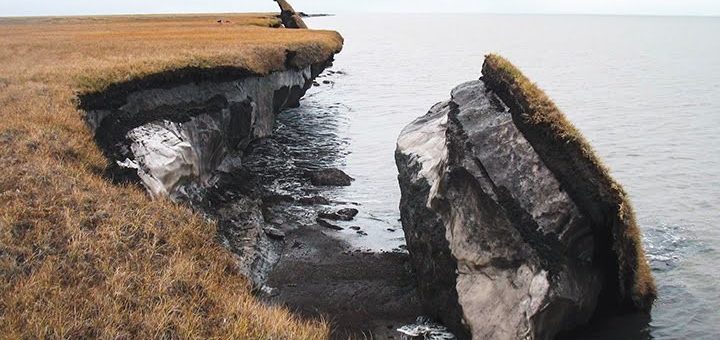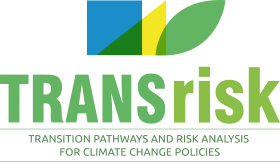Permafrost occupies 24% of the Northern Hemisphere’s land surface and is warming faster than the global average, thus melting permafrost: which has significant implications for efforts to control climate change. Quantities of organic carbon become available: permafrost contains twice as much carbon as in the atmosphere. The presence of permafrost carbon requires that the reduction of fossil fuel and industrial CO2 emissions needs to be greater and occur earlier.
Permafrost (permanently frozen ground) is a major component of the Arctic region occupying 24% of the Northern Hemisphere’s land surface. The Arctic region is warming faster than the global average, and permafrost is melting as a result. This melting has significant implications for efforts to control climate change.
Observed warming in the Arctic area over the last 30 years is as high as 3°C in parts of Northern Alaska, and as high as 2°C in parts of the Russian European North. This is between two to three times the global average, and exposes large areas of permafrost to thawing. A reduction in permafrost thickness and surface area is being observed as a result.
As previously frozen soils thaw, substantial quantities of organic carbon become available for decomposition by soil microbes. Permafrost contains twice as much carbon as is currently stored in the atmosphere and the release of a small fraction – in the form of carbon dioxide (CO2) and methane (CH4) – may lead to a positive feedback and increase the rate of future climate change.
Although the extra warming caused by the Permafrost Carbon Feedback (PCF) has been investigated, this feedback is not currently incorporated in economic assessment models. TRANSrisk report “Economic implications of climate change” examines the implications of permafrost thawing within a climate change control setting.
Specifically, the report examines the additional efforts required to maintain a radiative forcing of 2.6 Watts per m2 (Wm-2) in 2100 when the estimated extra emissions from permafrost thawing are added.
Scenarios and methods
The report first sets a radiative forcing target of 2.6 Wm-2 for the year 2100 (allowing for “overshooting” during the century) following the (Representative Concentration Pathways (RCP) approach used by IPCC.
Two scenarios are considered: The first scenario does not consider the permafrost carbon feedback, while the second one does. The goal of the study is not to conduct a probabilistic analysis, but to estimate how the expected permafrost carbon feedback impacts climate change with all other factors being equal.
The report uses the Dynamic Integrated Climate-Economy (DICE) model, a well-known Integrated Assessment Model (IAM) of climate-change economics. In this approach, society invests in capital goods, thereby reducing consumption today, in order to increase consumption in the future. Investing in emissions reduces consumption today but prevents future damage from climate change.
In this study an optimal path for fossil fuel and industrial CO2 emission reduction is sought that maximises the net present value of cumulative economic welfare from 2010 to 2100, subject to a constraint on radiative forcing (2.6 Wm-2 in 2100). In this approach economic welfare corresponds to net welfare, i.e. the damages from climate change and the mitigation costs have already been deducted.
Results Analysis
Figure 1 below depicts the resulting CO2 emission pathways to reach the 2.6 Wm-2 climate change control target. The results indicate that in the presence of a permafrost carbon feedback fossil fuel and industrial CO2 emissions need to peak between 5 to 10 years earlier.
Figure 1. Implication of PCF for fossil fuel and industrial CO2 emissions (GtCO2)
The presence of a permafrost carbon feedback requires that the reduction of fossil fuel and industrial CO2 emissions needs to be greater and occur earlier. This implies that the price (tax) of carbon must be higher, both now and in the future (Figure 2).
In the absence of the permafrost carbon feedback, the global price of CO2(assuming all counties participate) would need to rise from 36 US$/tCO2 in 2015 to 180 US$/tCO2 in 2050. In the presence of a permafrost carbon feedback the respective increase would need to be from 41[38-46] US$/tCO2in 2015 to 210 [200-240] US$/tCO2 in 2050 (Figure 2).
Figure 2. Implication of PCF for carbon prices ($/tCO2)
The higher carbon price implies higher costs to society. The presence of a permafrost carbon feedback would increase the total mitigation cost from US$8.1 to US$9.0 [8.5-9.8] trillion, equivalent to a 6-21% increase (Figure 3).
Devoting more resources to mitigation implies a reduction of consumption and investment, implying a loss in welfare. Our results show that the net present value of total welfare from 2010 to 2100 is reduced due to permafrost carbon feedback by US$ 4.2 [2-7.8] trillion.
Figure 3: Implication of PCF for mitigation costs (Trillion 2005$)
Sensitivity analysis for the mitigation cost
The mitigation costs obtained in the study are in the low range of the literature. There are two important factors explaining this result: the first being the discount rate and the second the cost of the backstop technology.
To address this, the sensitivity of the mitigation cost has been studied towards changes in i) the pure rate of social time preference (ρ), which refers to the willingness of consumer to delay consumption, and ii) the cost of backstop technology (pback), which refers to the cost of a carbon-free technology that puts an upper limit on the cost of CO2 mitigation.
The sensitivity analysis shows that the discount rate and the price of backstop technology significantly impact the mitigation costs. However, more importantly for the study, the relative additional mitigation costs are far less affected.

This article is derived from work undertaken for Deliverable “D4.1: Economic implications of climate change” of the TRANSrisk project. This deliverable, and other TRANSrisk outputs can be downloaded from the project website (http://transrisk-project.eu/content/transrisk-results).
The study was published in Climatic Change journal: http://dx.doi.org/10.1007/s10584-016-1666-5
Featured image credit: Soil Atlas of Northern Circumpolar Regions
TRANSrisk
Project details
- Project title: “Transitions Pathways and Risk Analysis for Climate Change Mitigation and Adaption Strategies” (TRANSrisk)
- Funding scheme: European Union Horizon 2020 Programme (EU H2020, grant agreement no. 642260)
- Duration: 3 years (1 September 2015 – 31 August 2018)
- Project coordinator: Science Policy Research Unit, University of Sussex, United Kingdom
- Project website: www.transrisk-project.eu



